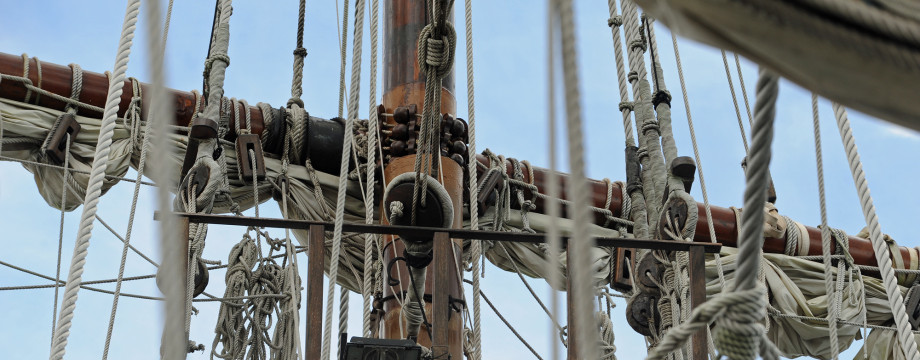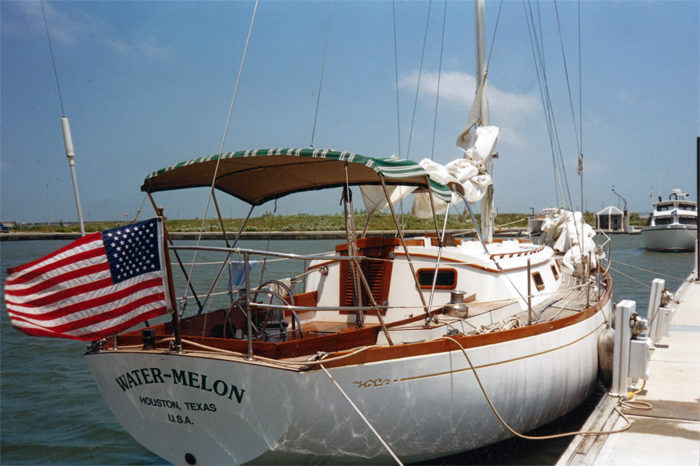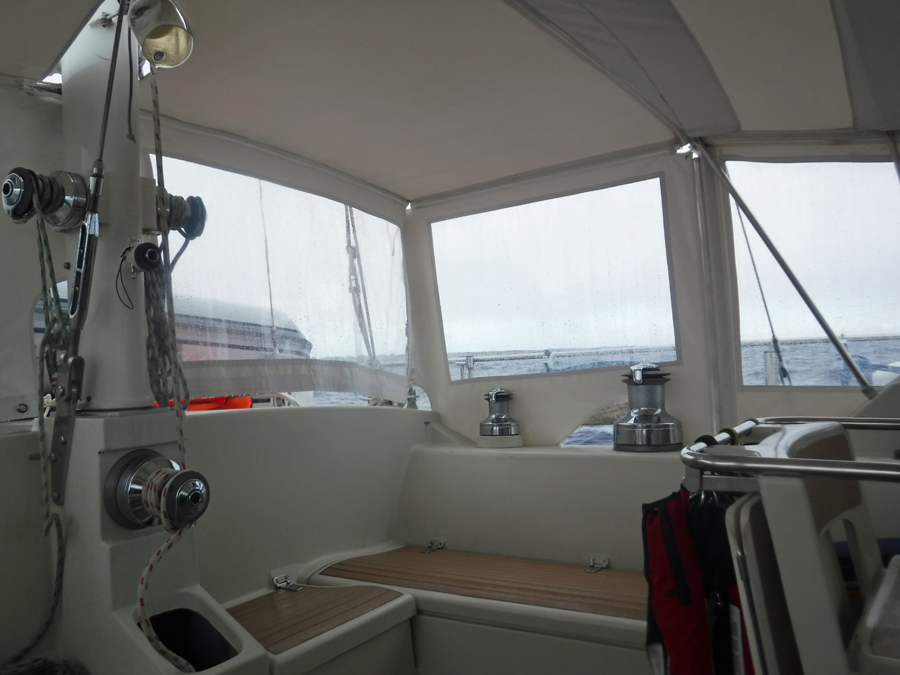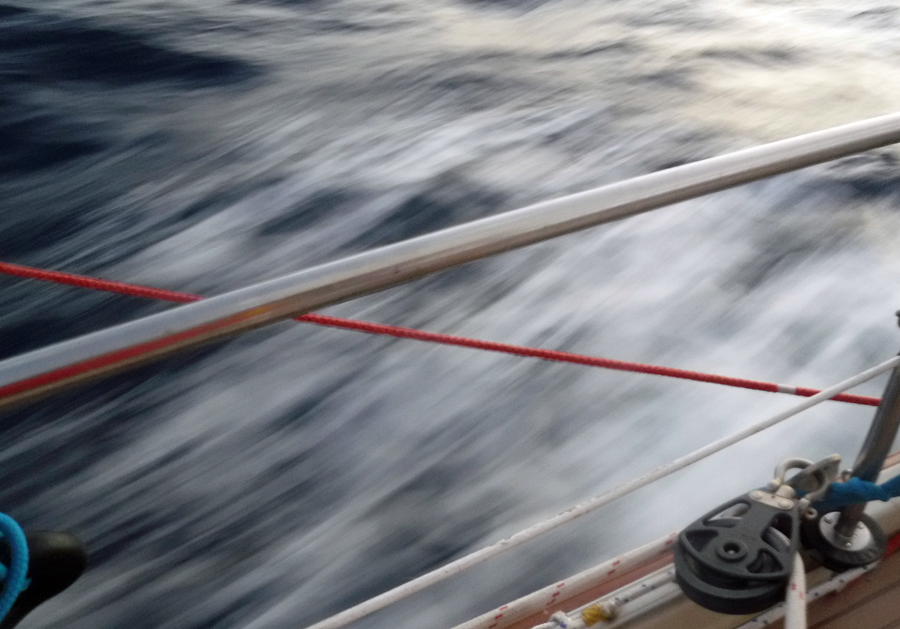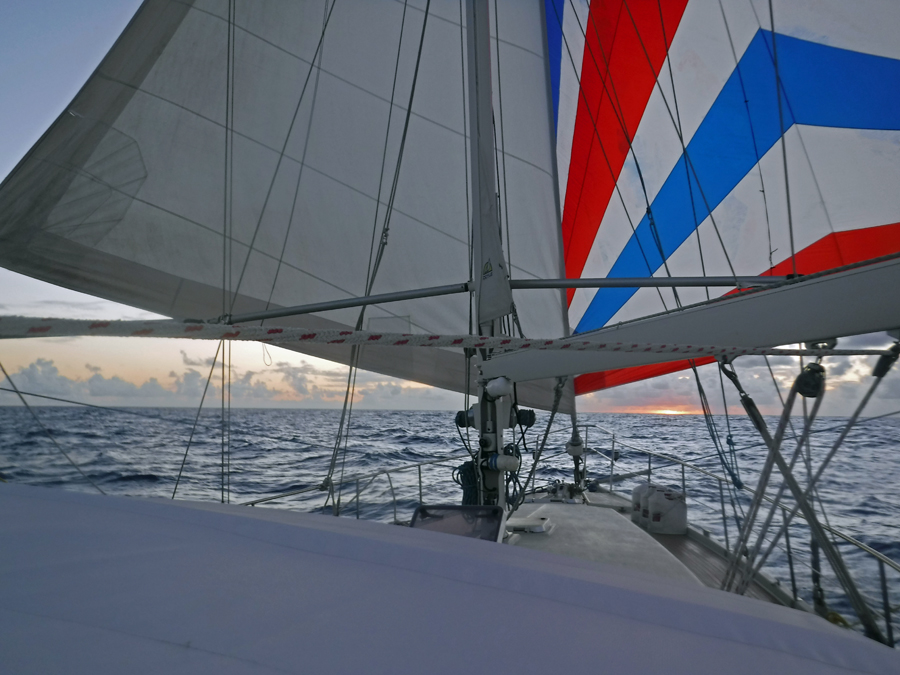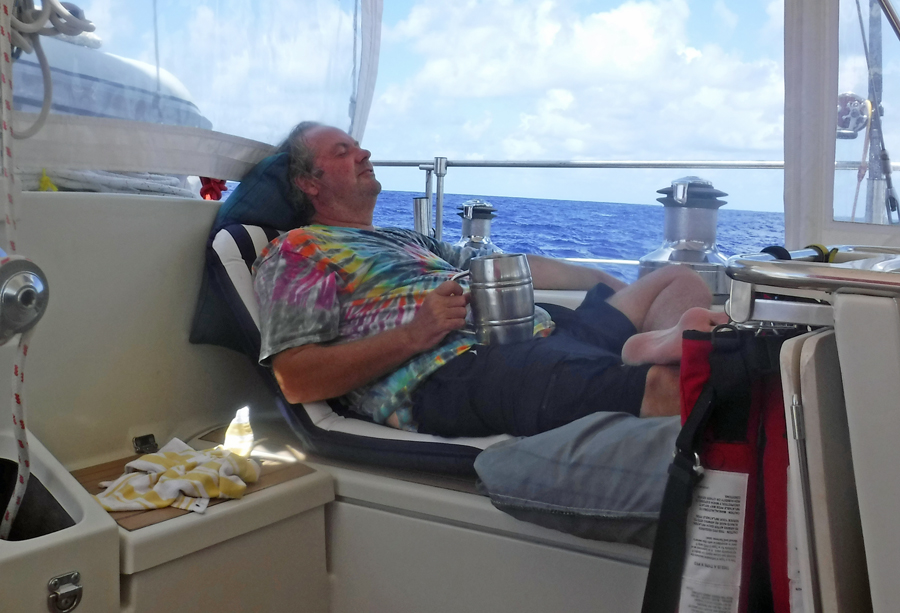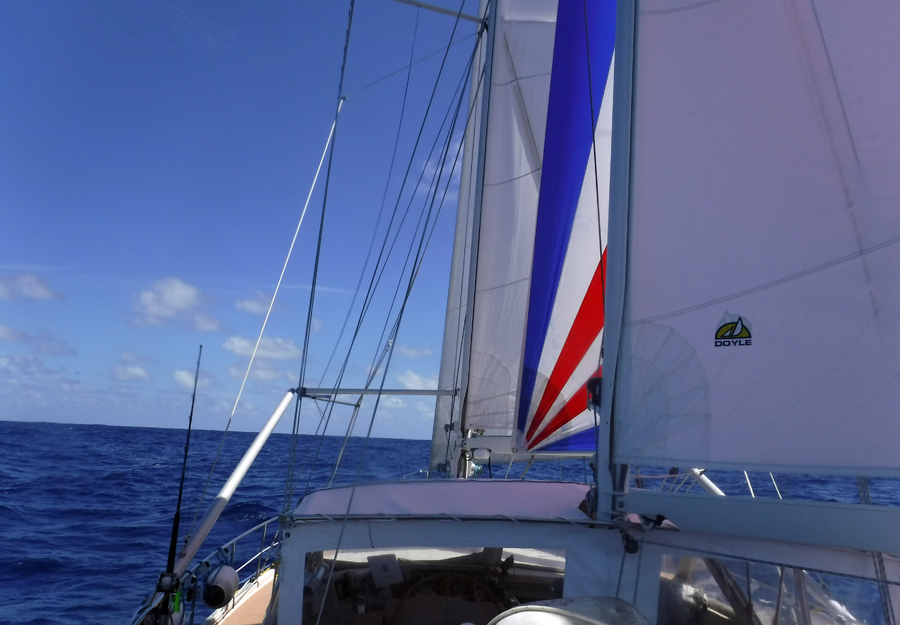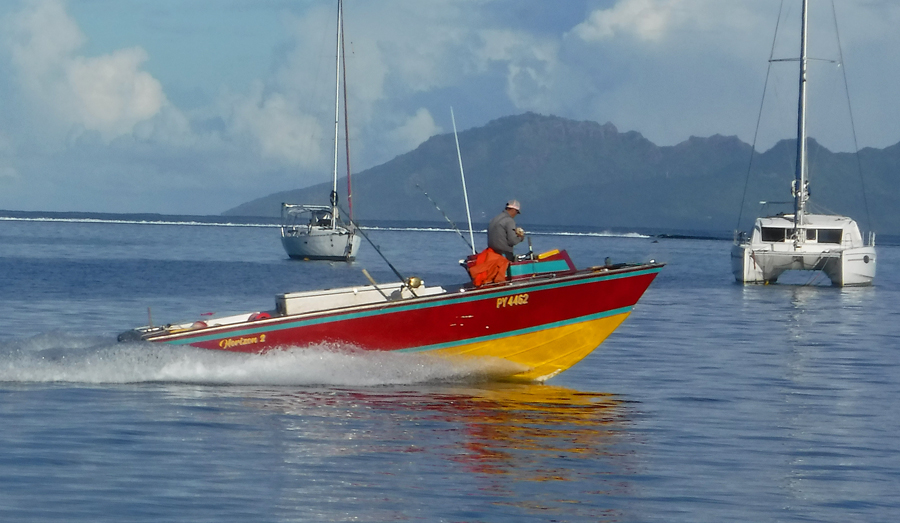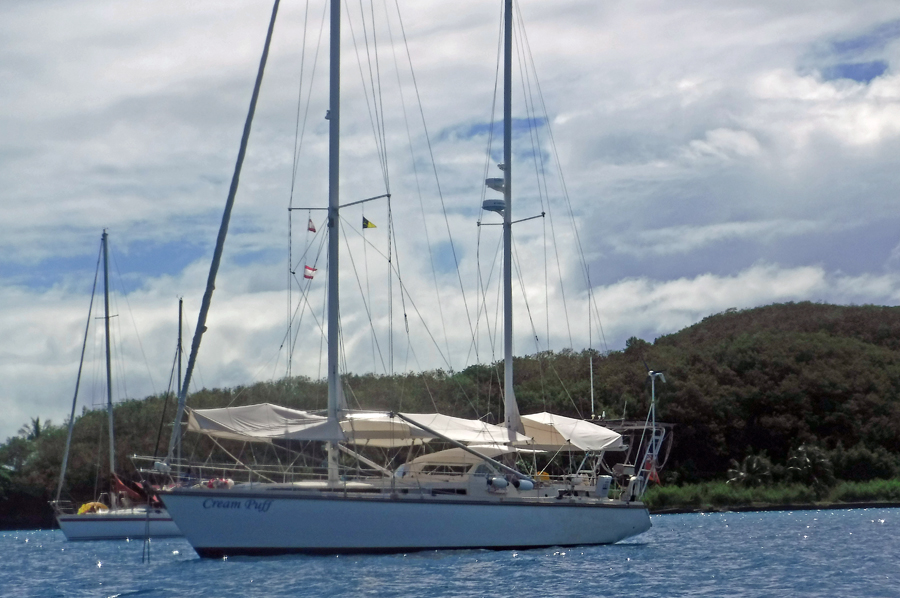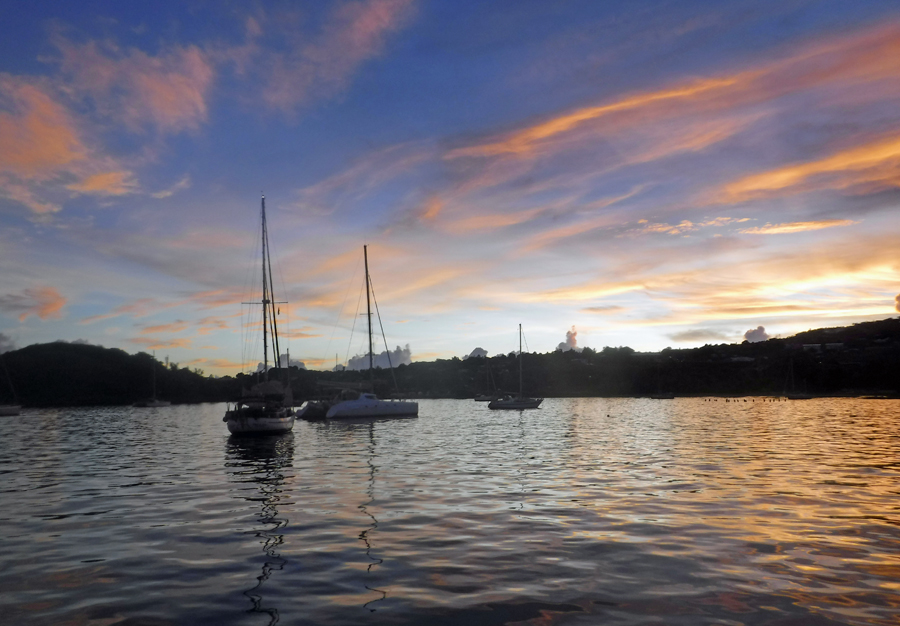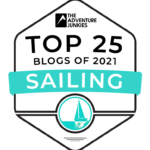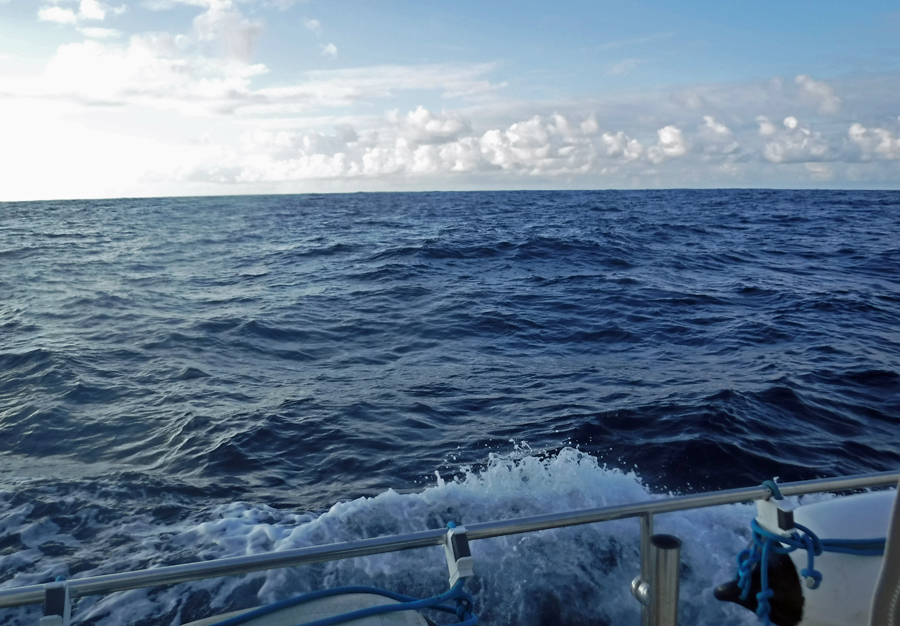
Our view for 29 days
You would think to be in the middle of the ocean as a contagious virus infects people all about the globe is be a good place. It is and it isn’t.
First and foremost, our crossing of the South Pacific Ocean was awesome. We had great weather and absolutely enjoyed the experience. After leaving Galapagos, we needed to get out of the ITCZ and pushed south to the trade winds. We had calm winds for about three days and one day of hard rain making this the most frustrating part of the journey. After we reached the trade winds, our weather was perfect for the next 26 days; following winds of 15-20 knots and seas less than 6 feet (2 meters). For the most part, we had perfect weather. Yes, there were the occasional squalls but really nothing frightening. We simply could not have asked for a better crossing.
In our younger thirties, we owned a boat called Water-Melon which we sailed in Texas on the Gulf of Mexico. Down the dock from us was a couple with whom we made great friends, Bob and Mona (not the same Mona as our Land Crew Mona whom write about). They were quite a bit older than us and referred to us as the kids. One day when walking the docks with Bob and looking at boats, something we often enjoyed doing together, Bob made a statement that has stuck with me my entire life. He said, “I always wanted to sail the South Pacific Ocean. Unfortunately, I’m too old now”. I didn’t say anything at the time. However, in the back of my head, I heard these words for the rest of my life. Those words resonated and entrenched themselves deep within me and helped shape our sailing future. Never put off your dreams. Before the term bucket list became popular, both Cindy and I had a dream of sailing and exploring the South Pacific Islands.
As we sailed in the Caribbean Sea and up and down the Atlantic Ocean, we have often wondered what it would be like to sail across an ocean. We sailed passages of 5 or 7 nights out pretty regularly. However, we both questioned if we had it within us to sail for 3 weeks. On some of our “not so pleasant passages”, we convinced ourselves this was not something that was ever going to happen. On the nice passages, we felt like we could sail forever. So why did we set out and sail for over 3,000 nautical miles if we were unsure? The harsh truth, neither one of us wanted to be like Bob. I would hate in my future to walk the docks of a marina with my much younger friend and say those same words. The lure of wanting to sail the South Pacific was much greater than the fear of doing what is needed to get here.
This trip was supposed to be a dream come true. It was and it wasn’t. This is going to sound very selfish; the Covid-19 Virus diminished the impact of our accomplishment and instilled us with a huge amount of angst along the way. What was supposed to be an adventure fulfilling a lifelong dream turned out to be days and days of anguish combined with the excitement of the adventure. Mixed feelings, indeed.
On our departure date in Galapagos, for a short time, we both hesitated about leaving. It had nothing to do with the virus or any apprehensions about the long journey. It had to do with the wild swings in the stock market indicating troubled times ahead. This year we expected to see a selloff. Just about any analyst worth their salt was predicting a downward market adjustment. Right before the customs and immigration officials arrived at our boat to give us clearance to leave, Cindy and I had a conversation. We are going to be out of communication for at least 2 weeks, maybe 3. Are we comfortable with our financial positions should this be the beginning of the anticipated selloff? Once on the ocean, there is nothing that can be done since we have very limited communications. The answer was yes. We believed even in a selloff we were well positioned to ride the downward wave (pun intended). We set sail.
To put this timeline into perspective for you, Trump had just visited the CDC in Atlanta. When asked by a reporter if the USA was prepared for the virus his response was, ‘we have nothing to worry about. It is just one person coming from China. We have everything under control’. He went on to blame the news media talking about the virus as “fake news”. On email, we received jokes from friends about how badly people were over-reacting. The massive U.S. toilet paper calamity of 2020 had not yet happened.
The French Polynesian Islands had just implemented a policy requiring people arriving by plane to present a health certificate not more than 5 days old stating they were checked, healthy, and virus free. Cruise ships were still allowed to dock in Tahiti so long as no cases of the virus were aboard. We checked with the French Embassy in Panama and were given the okay to depart. We also checked with our agent on Tahiti and were again told no problems existed and to set sail. What is an agent? This is a company or person who for a nominal fee will aid us in navigating the government red-tape regarding clearance procedures and visas for private yachts. We make it a practice to use an agent if the fees are reasonable. More often than not they are worth the money. Many cruisers we know like to save the expense and navigate the process themselves. However, one mistake can cause a big hardship (more on this later).
After three days at sea and dealing once again with the ITCZ and the rainy doldrums, we finally managed to get a little wind in the sails. Because of the length of the passage, we didn’t dare to use the engine to offset the light winds. Besides, this is a sailing adventure. We would rather sail. Conservation of diesel is a must on long passages. We just took our lumps and bobbed about like a cork drifting with the current and were happy when we finally made more than 5 knots of speed. We tend to lose all track of time on long passages. I am not exactly sure when we started to receive messages from our friends telling us how the world was ending.
As previously mentioned, at sea we have very limited communications. We can email, call, and text using our satellite phone or text on our InReach device. The satellite phone is expensive to use. Its primary use is to get updated weather forecasts. On the InReach, we have an unlimited text plan but it is limited in characters and functions. We started to receive messages saying people all around the world were dying. We received messages about a massive stock market crash. As you can imagine, the worst thoughts start to rattle about in my brain. Are we talking millions of deaths and a pandemic similar to that of the 1347 – 1353 plague years were an estimated 200 million people or half of the world’s population died? Is the stock market crash like that of the great depression where people jumped out of skyscraper windows in New York City? When I asked for clarification and detail, it was hard to understand why there was so much panic. Frustration set in since we had so little information. Needless to say, there was a level of angst for both of us. With our limited communication and details, we decided we’d just deal with whatever is happening the best we can when we make landfall and decided to enjoy the trip. Then, the bomb dropped.
Our agent from Galapagos texted us and told us French Polynesia might close its borders entirely. We were almost halfway when we received this. He suggested we contact our agent there for clarification.
Look at a globe. If we cannot stop in French Polynesia (an area the size of Europe), other options are very limited and very far away. We could turn north to Hawaii. Both being US citizens they have to let us in, don’t they? We could continue to sail west indefinitely until we die of starvation. This would be a very long way since we have tons of food aboard and can make our own water. Are any other islands open for us? We have no idea and no way to find out. And, even if an alternative destination were available would the borders still be open when we arrive?
Our agent in Tahiti told us things were changing rapidly, very rapidly. She told us to keep going but she was unsure of developments. She needed clarification of new rules and would let us know more details as soon as she could. About 5 grueling days went by as we waited to find out if we were allowed to continue to our destination in the Marquesas, the closest of the French Polynesian islands. As you can imagine, between news of people dying, stocks crashing, and not knowing about our intended destination, we had trouble maintaining any sort of inner peace.
This is, in actuality, the point in our journey where we experience the most highs and lows. Our trip was going well. Cream Puff was doing her thing. The Puffster really is a fine boat and sails like a dream. The weather remained great. The seas were nice (except for the southern swells). Cindy and I were in a nice routine. Our watch schedules were working well so we both felt rested. We ate well and were even able to take hot showers every day due to the good weather. The lows happened when we started to talk about the messages we were receiving. Speculation of the events didn’t help. We just had to tell ourselves we’d deal with whatever happens once we land somewhere.
We received a text from Cindy’s sister in San Antonio. She told us the city was locked down and people could only go outside for essentials such as food and medicine. The police were patrolling ensuring this new strict directive was obeyed. I thought, wow this must be really bad. So, I asked how many people had died in San Antonio due to the virus. I expected the answer to be in the thousands since the measures were so extreme. The reply I received perplexed me thoroughly. A single person had died. An eighty-year-old lady who was already in poor health. We must be missing something, I thought.
About 60 hours out of Nuku-Hiva in the Marqueas, we had a long string of texts and instructions from our agent. This was a relief. Finally, she had some answers for us. She gave us two choices. We could continue to Nuku-Hiva (our original plan) where we would be checked-in or we could continue to Tahiti and be checked in there. The keywords here are music to our ears: checked-in. We didn’t really mind much about a quarantine if required and figured it’d be a great way to catch up on some sleep. We were going to get checked-in! Little did we know, this was not yet a done deal.
Cindy and I had a short discussion about the choices we’d just received. We know Nuku Hiva is an outlying island in The Marquesas. Resources there for groceries and the internet would be limited. However, it was closer than Tahiti. The internet, groceries, or fuel were not the most important things. We agreed, the most important item on the top of our list was the processing of our carte de sejour (CDS) upon arrival.
The CDS is a two-part process, it requires a long-stay visa issued at a French Embassy before arriving in the islands. We did this in Panama (actually, Cindy did all the work). Then, the person with the visa must arrive within a specified window of time to file the remaining paperwork with the Haut Commissaire. Doing all of this allows us to stay in the French Polynesian Islands for as long as they will renew our CDS. We hope to stay here for 2-3 years, or more. This is a much friendlier policy than those of other countries who often force visitors to leave for a period of time before they can return.
Our decision was to sail to Nuku Hiva and we communicated this back to our agent. We made it very clear we would require our CDS application to be filed upon arrival. This was the most important thing for us. The clock was ticking on our arrival window. If we missed the window, we could be turned away. We received a confirmation the papers would be filed upon our arrival in Nuku Hiva. No problem. Someone would be there to help us with the process. Smiles all around and a sense of relief. Then once again, things changed.
At this point in our journey, we can almost envision seeing land. It is nighttime and we are talking about our arrival in the comfort of Cream Puff’s enclosed cockpit. We are excited. The prospect of walking on land is very near. We wonder what the island will be like. Our InReach device beeps. It is a message from the agent. In order to process the CDS we must now go directly to Tahiti. After further investigation, it was determined the office in Nuku Hiva would not process our application and we would not be fully checked-in until such a time as we arrive in Tahiti. We are somewhat okay with this. We had almost decided on Tahiti when we made our last big decision. But, it adds 7 more days and about 800 miles to our journey. We were so close! We turn the boat about 45 degrees and point to the southwest. I laid in a course into the ship’s navigation computer. It was sad to see our arrival estimate go from 3 days to 10 more days but we were still enjoying the journey part, just not the angst about the virus part. I go to bed.
We are about 4 days out of Tahiti. Our agent is aware of our progress and we give them a rough ETA. We are then told we must complete a DPAM form so our arrival can be approved. What? We thought we were already approved. Can we still be turned away? We are very lucky we can receive email while underway. It is expensive but in cases such as this, who cares. Besides, we may not have any money when we get to Tahiti. We have no idea how badly the stock market crashed. For all we know, we might not be able to pay our phone bill. Cindy does the paperwork. On the form, the information requested is very straight forward. It asks about our needs and intentions in addition to where have we been and when type questions. On the bottom of the form are two boxes to be completed by the government official: Approved and Denied. I find this daunting. We can still be denied? On the form, Cindy pleads our case: If we are not allowed in Tahiti, we will die. Even though I say this tongue-in-cheek, our options were now very limited.
We are very fortunate someone in the French Polynesian Government had a level head during the writing of the new regulations. We knew of about 40 sailboats en route to French Polynesia. To ask these boats to turn around is not possible due to the tradewinds. To continue onward toward the west would put us in the heart of the cyclone belt at peak season. This is not a good place to be. Some U.S. boaters re-routed themselves to Hawaii due to all of the unknowns and rumors now rampant among the sailing community. We thought going to Hawaii to be a bit rash since the borders of Tahiti are still open to arriving vessels, with approval. The approval we are still hoping to get. The local Government was empathic to our situation and continued to allow boats who left the Americas prior to the new rules to enter the country. A couple of uncertain days passed before confirmation of our approved application is received allowing us to make port in Tahiti. Had we have waited a week in Galapagos, we might not have been so fortunate. Who knows where we’d be today.
An added plus of having an agent at this point: they tend to know what is approved and what is not. Our agent was also able to file the form on our behalf. For sailors doing this themselves and trying to keep up with the ever-changing regulations, it is just about impossible. FaceBook groups were full of cruisers asking questions about new regulations and receiving non-factual advice. In my opinion, entrusting something as important as this to advice from a perfect stranger on FaceBook (who may or may not be who or where they say they are) is a massive lack of judgment. A single mistake could result in being turned away with no other options.
We are also told to contact the JRCC (Joint Rescue Coordination Center) via email with information regarding our vessel, health, and previous ports of call including dates of departure. The agent informed us the JRCC may wish to contact us for an interview on the ship’s radio. We sent the email as instructed.
Aboard Cream Puff, our conversation now revolves around where we were going to anchor. The marinas in Tahiti do not take reservations. They are first-come, first-served. We have no idea if they have any room available. There are mooring buoys but we are unsure about who operates these and the frequency of service. If we are going to attach our home to a buoy, it’d be nice to know how secure it is. Floating off in the middle of the night due to a buoy malfunction usually doesn’t have a happy ending. All of our homework prior to setting sail was done on landing in the Marquesas Islands. Other than the charts aboard, we have little information on landing in Tahiti. I am concerned since I am under the understanding Tahiti has an islandwide anchoring ban. This turns out to be more bad information posted on FaceBook. Yes, there are some areas where Tahiti is looking to ban anchoring however, it is not islandwide and plenty of anchoring room exists elsewhere about the island. For now, due to the large number of boats being directed to Tahiti from other French Polynesian islands due to the government’s virus actions, the ban proposal was shelved.
We watch the estimated time of arrival carefully on our ship’s navigation computer. It is essential we make a daylight landing. There are reefs surrounding the island and access between them can be narrow. In addition, admission is restricted by the authorities. About 12 hours away, the wind dies. We crank up the engine for the first time since leaving Galapagos 29 days ago. Our agent has faxed our approved DPAM form to the Pape’ete Port Captain and confirms for us there are English speaking radio operators who will assist with our entry. Arrival after 6 pm has tighter restrictions and might require a temporary anchor site until daylight the next day. Things are looking good.
At about 4:30 pm local time we contact the Pape’ete Port Captain on our VHF radio and inform them we are about 30 minutes out. I smile as I write this sentence. We honestly had no idea what time it was. We have just sailed across three time zones and all of our clocks say something different. The only clock I know to be correct is the one at the navigation station set to UTC. But, we are unsure how many hours difference UTC is from Tahiti. In addition, some islands in French Polynesia have half-hour time differences making time even more confusing. We thought it was 5:30pm locally and thought we were really pushing our luck on the 6 pm rules. Looking at the height of the sun, I figured I had plenty of time to navigate the inner channel of the island. It wasn’t until later we found our error and discovered we had ample time.
The port captain tells us to contact him again when we are five minutes from entry. We do so and request permission to enter and proceed onward to the anchorage site near Taina Marina. We are granted permission and told to continue on the inland channel and contact him again when we are five minutes from the airport for further clearance. I agree and turn to Cindy, “What airport?”
We consult our charts again and discover the channel closely passes the end of the island’s main airport. I then understand why we need clearance to proceed past the facility. Having a 65’ tall mast at the end of the runway is not something a pilot might enjoy seeing.
We pass the airport at both ends of the runway as the channel arcs. Once clear of the airport the port captain gives us the all-clear to proceed to the anchorage site. We are both exhausted. All we can think about at this point is going to bed. But, we don’t. We force ourselves to stay up and enjoy a celebratory meal and a bottle of fine French champagne. We contact, Mona (a different Mona from the Bob and Mona) who is our land contact and confirm our safe arrival. She raises a shot in honor of our accomplishment. We virtually toast one another. Cool beans! We are in Tahiti!
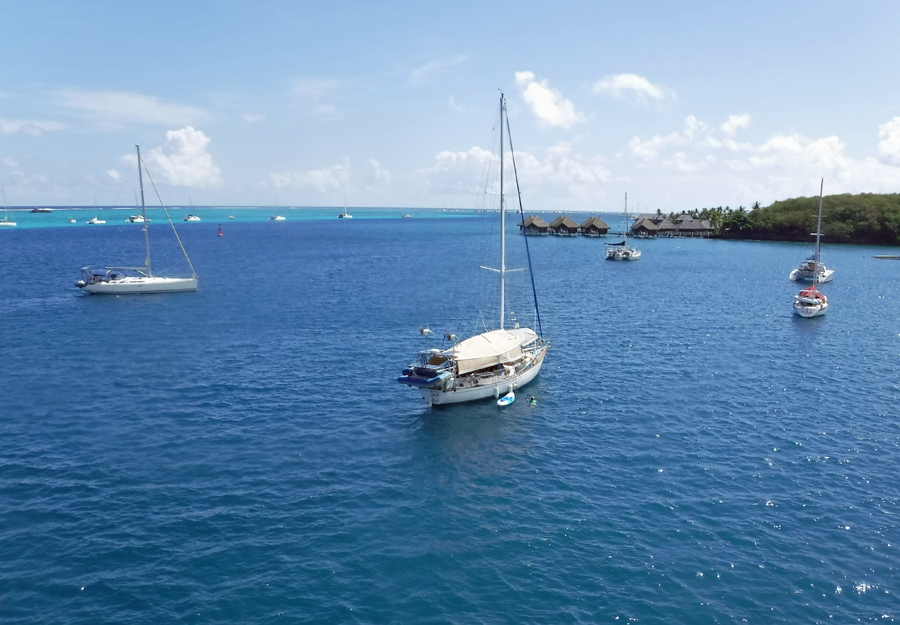
From halfway up the mast, our neighbors are a British couple on Spirit of Argo (center) – We are readers of their blog and now we’re neighbors
Our agent has arranged for us to check in with customs and immigration the following morning at 8 am. We confirm what time it really is. The officials do not allow people to come to their office due to the local virus restrictions. All meetings must take place in an open area and we are to remain 2 meters apart from them. We meet under a tree in the marina after hitching a ride from a neighboring boat on their dinghy to the marina (another story for another day). We legally enter the country and our agent begins the process of the CDS application. A big sigh of relief.
For boaters arriving in the French Polynesian islands without a long-stay visa, an EU passport, or the ability to apply for CDS, the situation is far less welcoming. They are not allowed to stay. Many were here with intentions to move onward out of French Polynesia within their standard-issue 90-day visas. The islands west closed their borders due to the virus and the boater had no ability to stay using their visas. Their only choice was to leave their boat here and catch a charter flight out of Tahiti to their home country (repatriation). Tahiti is littered right now with abandoned boats. Patrols in the area are ensuring the vessels are kept under the eyes of the authorities to avoid break-ins. The entire fleet of the World-ARC is here. The ARC has been canceled and the owners and crew repatriated. I can’t help but wonder at what point the owners will be allowed to fly here and get back aboard.
It is a little bit unfortunate our first sailing over an ocean was in harmony with the angst of the Covid-19 outbreak. However, the angst we felt during the passage was nothing compared to the thrill. The trip was fabulous. We can now confirm we have what it take to sail across an ocean. Cindy asked me if I’d want to do it again. We both agreed we would. But, we wouldn’t do it just for the heck of it. For us, the reward of this ocean crossing is what lies ahead for us as our adventure continues in a part of the world so few people experience.
